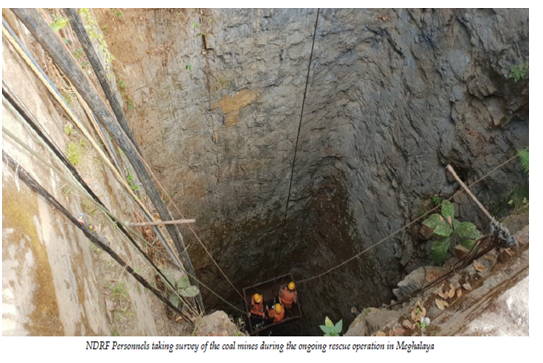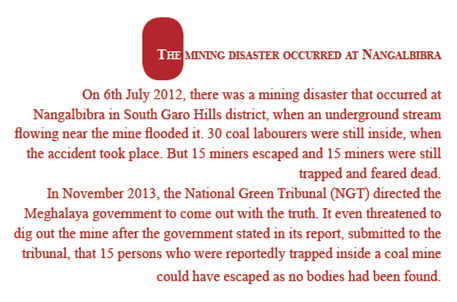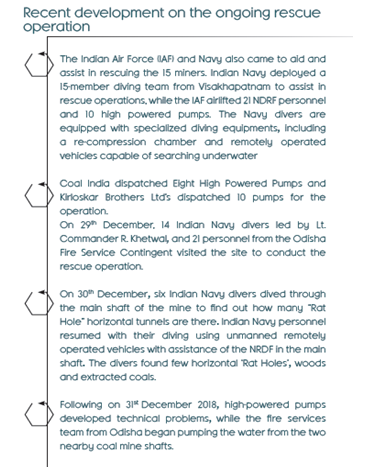
The rescue operations for the 14th miner trapped in coal mines of East Jaintia Hills which happened on 13th December 2018 have failed in all aspects. The rescue teams as well as public have put blame on the State Government and District Administration in failing to provide tools and equipments for the operation. It has been over two weeks since the incident and families of the victims still throng to the site with hopes to see their bread earner one more time. Till filing this report, neither the Chief Minister nor the Minister of Disaster, Government of Meghalaya paid a visit to this area. Though the National Disaster Response Force (NDRF) has been involved since 14th of December 2018, yet it’s Chief, Shri Sanjay Kumar has not yet visited the site. It is clear that the State Government does not have the equipment or the skills to deal with a disaster like this, even with the involvement of NDRF, the lack of proper equipment and tools such as high powered pumps have failed the rescue operation in every way. Instead of using 100 hp pumps, the NDRF were only supplied with ten (25 hp pumps) out of which eight of them broke on the third day of rescue. State Disaster Response Force (SDRF) Inspector N. Nonglang said that with the current scenario of the water, only high-powered pumps can help the teams to reduce the water level in the mines. The Government of Meghalaya and District Administrative should collectively take blames regarding this failure to save the lives of those 14 nameless miners in East Jaintia Hills.

Till 2014 officially, coal mining was said to be the biggest revenue generator for Meghalaya.The Statehas nearly 640 million tonnes of coal reserves. Mining of coal by hand has been going on in the State for over 150 years, mostly for local use. Large-scale illegal and indiscriminate mining of the coal by private landowners and the local community started nearly three decades ago. Most of these mines employ minors, some from neighbouring states including Nepal as well. The miners work hundreds of metres underground in unsafe conditions, mining coal with their bare hands. For mining, the land is first cleared by cutting and removing the ground vegetation and then digging pits ranging from 5 to 100 m into the ground to reach the coal seam. According to NGT reports, tunnels are made into the seam sideways to extract the coal which is brought into the pit by using a conical basket or a wheelbarrow manually. Coal seams are reached by excavating the side edge of the hill slopes and then coal is extracted through a horizontal tunnel. Rat hole mining is much prevalent in Jaintai Hills, one can see heaps of coal covered with tarpaulin, when going to the areas especially, when one passes from Lad Khlieh Riat via Lad Sutnga to Sutnga.Though Meghalaya is being protected by the norms under the Six Schedule on the right of ‘Land Ownership’ yet with the ‘Nationalization Act of 1973’ on ‘underground minerals’, the State Government can take ownership on Coal Mines but even after 47 years of statehood, Meghalaya has not come out with any Mining Policy. The mining activity in the State still remains a small scale venture controlled by individuals, who owns the land in a primitive method, commonly known as ‘rat-hole’ mining. Apart from the environmental issues the safety of miners was among the reasons cited by the NGT, when it put a ban on illegal mining in Meghalaya since 2014.
Despite a four-year-old ban on coal mining by the National Green Tribunal, illegal mining activities in the State cannot be hidden forever. This unfortunate incident in Lumthari, where 14 miners were fear death trapped in a flooded illegal coal mine in Meghalaya’s East Jaintia hills district on 13th of December, clearly sums up the truth claimed by the Government. After repeatedly denying the existence of illegal coal mines in the State, Chief Minister Conrad Sangma, apart from expressing his condolences for the victims, on 14th December morning through a video message admitted that “there could have been situations and instances where it was happening. Physically sometimes it is not possible for us to go to every nook and corner. We do have our challenges in terms of manpower. It is very difficult for us to cover the whole state”.
mining activities in the State cannot be hidden forever. This unfortunate incident in Lumthari, where 14 miners were fear death trapped in a flooded illegal coal mine in Meghalaya’s East Jaintia hills district on 13th of December, clearly sums up the truth claimed by the Government. After repeatedly denying the existence of illegal coal mines in the State, Chief Minister Conrad Sangma, apart from expressing his condolences for the victims, on 14th December morning through a video message admitted that “there could have been situations and instances where it was happening. Physically sometimes it is not possible for us to go to every nook and corner. We do have our challenges in terms of manpower. It is very difficult for us to cover the whole state”.
 mining activities in the State cannot be hidden forever. This unfortunate incident in Lumthari, where 14 miners were fear death trapped in a flooded illegal coal mine in Meghalaya’s East Jaintia hills district on 13th of December, clearly sums up the truth claimed by the Government. After repeatedly denying the existence of illegal coal mines in the State, Chief Minister Conrad Sangma, apart from expressing his condolences for the victims, on 14th December morning through a video message admitted that “there could have been situations and instances where it was happening. Physically sometimes it is not possible for us to go to every nook and corner. We do have our challenges in terms of manpower. It is very difficult for us to cover the whole state”.
mining activities in the State cannot be hidden forever. This unfortunate incident in Lumthari, where 14 miners were fear death trapped in a flooded illegal coal mine in Meghalaya’s East Jaintia hills district on 13th of December, clearly sums up the truth claimed by the Government. After repeatedly denying the existence of illegal coal mines in the State, Chief Minister Conrad Sangma, apart from expressing his condolences for the victims, on 14th December morning through a video message admitted that “there could have been situations and instances where it was happening. Physically sometimes it is not possible for us to go to every nook and corner. We do have our challenges in terms of manpower. It is very difficult for us to cover the whole state”. The Meghalaya Human Rights Commission, headed by its Chairperson Dr. Aftab Hussain Saikia and Member P. J. P. Hanaman had filed a ‘suo moto’ case against the Government of Meghalaya for compensation of the trapped labourers. Responding to the case, Meghalaya Chief Minister Conrad K Sangma, promised that strict legal action would be taken against all those, who were found to be involved in the illegal practice and the issue of compensation will come only after there is confirmation about the death.
District Police Chief Silvester Nongtyngnger said, that on 14th December the Police have arrested Jrin Chullet who is the owner of the mine after a raid in his home village of Norwan. One of his accomplices James Sukhlain is absconding and a manhunt has been launched to track him and others down. A case has been registered against the coal mine owner in Saipung police station under various sections of the Indian Penal Code, the Prevention of Damage to Public Property Act and the Mines and Minerals (Development and Regulation) Act.
The 13 miners who are trapped inside the coal pit includes Raziul Islam, Mozid S. K, Shirapat Ali, Omar Ali, Mezamur Islam of West Garo Hills Meghalaya, Mominul Islam Bogidar, Amir Hussain, Munirul Islam, Saiar Islam, Md. Samsul Haque of Assama and Chal Dkhar, Iong Dkhar and Nilam Dkhar from Lumtari, East Jaintia Hills Districts Meghalaya.
One experienced miner from Sohshrieh, who choose to be anonymous said, that the miners who are trapped, are new to this kind of mining and they lack experience as they have accidentally breached to another old coal mine filled with water which in result was flooding the mine in which they were working.
Currently a team combined of at least 70 personnel from the National Disaster Response Force (NDRF) and over 20 personnel from the State Disaster Response Force (SDRF) are in the process of retrieving the miners.
Response Force (NDRF) and over 20 personnel from the State Disaster Response Force (SDRF) are in the process of retrieving the miners.
 Response Force (NDRF) and over 20 personnel from the State Disaster Response Force (SDRF) are in the process of retrieving the miners.
Response Force (NDRF) and over 20 personnel from the State Disaster Response Force (SDRF) are in the process of retrieving the miners.According to the State Disaster Response Force (SDRF) Inspector Mr. N. Nonglang, the size of the mine shaft main tunnel is approximately 2 ft wide and 370 ft deep. Nonglang said “it is clearly understood that the mine is old and by studying the main tunnel, it can be assumed that the miners might have resume mining in this shaft only few days back, as even the camp site looks new”. One of the victim’s nephew who was operating the crane, learned about the incident only after they were back from lunch. They were worried as none of the miners came up for lunch. It was only after 2 pm, the authorities were informed and around 4 pm a pump was pressed into service to drain out the water. There are around 10 old mine shafts which are not far from each other on both the sides of the Lyntein River. According to one of the victims relative Krishna Bahadur Limbu, the people who were trapped in the mine include six from West Garo Hills, four from Assam and three from the adjacent area of Lumthari Village. Nongalng recalled, that this is the first of its kind incident, where the water suddenly rise and entered the coal pockets and trapped the miners, but in the past, coal mine accidents have been happening in the State from time to time, for instance in February 2014 four miners were killed when the walls of an illegal mine collapsed in Garo Hills. In December 2013 five miners died when the cable of the contraption which was carrying them down to an illegal mine in Jaintia Hills broke and in July 2012, 15 miners drowned in an illegal mine in Garo Hills when an underground stream flowing near the mine flooded it.
Donboklang Wanniang
To read the further article please get your copy of Eastern Panorama January issue @http://www.magzter.com/IN/Hill-Publications/Eastern-Panorama/News/ or mail to contact @easternpanorama.in


